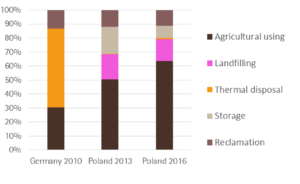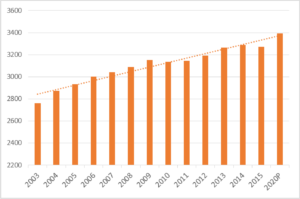Sewage sludge is according to the definition included in the Waste Law (dated 14’th of December 2012) – “sludges from fermentation chambers and other installations used for the treatment of municipal wastewater and other wastewater with a composition similar to the composition of municipal sewage coming from wastewater treatment plants”. The average calorific value of sewage sludge is about 10 – 16 MJ / kg, so as in the case of municipal waste also sewage sludge cannot be landfilled. This prohibit has been in force since January 1, 2016, i.e. entry into force of the provisions of the Regulation of the Minister of Economy on the admission of waste for landfills of 16 July 2015.
In Poland, the amount of agricultural use of sewage sludge is growing, while thermal utilization still plays a small role in the sewage sludge management. Germany as a reference country largely uses sewage sludge in thermal processes, thus reducing the amount of sludge, which is landfilling or using agricultural.
Fig. Sewage sludge management in sewage treatment plants 2,000 -10,000 PE in Poland and Germany

Theoretically, the law allows for cultivating fields with stabilized sludge, but in practice regulations are not strictly obeyed. As reported by National Inspection Chamber in Poland, the quality standards of sludge used for agricultural were not met. For example:
- As much as 90% of the treatment plants did not provide land users with reliable sludge and soil tests or sediment dosage information that they could use.
- More than 13% did not perform laboratory tests at all, while the quality of the others did not guarantee land protection against contamination.
- More than 40% of the inspected sewage treatment plants used sewage sludge in places that are not allowed, eg. in areas subject to nature protection, built-up area, near water intakes or during vegetation of plants intended for direct human consumption.
Source: Update of the National Sewage Treatment Plan 2013, 2017, Municipal sewage sludge – analysis and evaluation of selected aspects of sediment management, Tadeusz Pająk 2010
- Nearly half of the water treatments plants stored sewage sludge under conditions that could pose a threat to the environment (on unhardened or uncovered ground).
- Sewage sludge tests in most of the plants (63.9%) were performed too rarely or with mismatched samples.
The largest sewage treatment plants located in big polish cities do not use agricultural methods in sludge management. Due to the amount of produced sewage sludge and access to larger financial resources, they invest in the construction of sewage sludge mono-incineration plants. In Poland there are 11 sewage sludge incinerators, located in the areas of the largest sewage treatment plants (Zielona Góra, Łomża, Bydgoszcz, Gdańsk, Gdynia, Cracow, Kielce, Łódź, Olsztyn, Szczecin, Warsaw).
However, it should be noted that several facilities are not able to develop the amount of sewage sludge in the country (over 2,500 of all water treatment plants). In addition, the dispersed location of small water treatment plants throughout the country would result in the need to transport sewage sludge long-distance.
Due to increasing amount of sewage produced, and thus also to the sewage sludge, the number of sewage treatment plants in Poland is constantly increasing.
Fig. Number of municipal sewage treatment plants in Poland

According to forecasts, the stream of sewage and produced sewage sludge will grow. This is due to a change in the lifestyle of society, but also to an increase in the number of people connected to the sewerage network.
Sources
- Assessment of energy usefulness of municipal sewage sludge based on the analysis of physicochemical parameters, Przegląd Górniczy, A. Skawińska, I. Kuklis, Institute for Chemical Processing of Coal in Zabrze, 2014
- Update of the National Sewage Treatment Plan 2013, 2017, Municipal sewage sludge – analysis and evaluation of selected aspects of sediment management, Tadeusz Pająk 2010
- Information from audits carried out by the National Chamber of Control in 36 units operating municipal sewage treatment plants – Sludge Landfill Development in Municipal Sewage Treatment Plant in 2011-2012;
